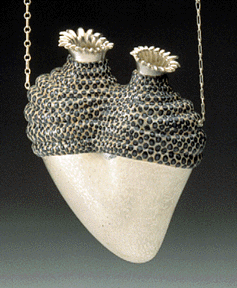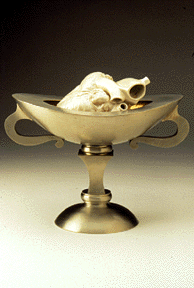

BACKGROUND
Metalsmithing is a field defined by objects - functional objects,
ritual objects, domestic objects, objects for adornment. These
objects share a commonality of materials and process. They share
as well the fact that their design is derived from their utility,
and their utility serves the needs of the human body. These fundamental
characteristics are what initially drew me to the field. I had
an immediate response to the materials; the visual richness of
silver and gold, the surprising tactile sense of a hard material
whose surface can feel soft and flowing. Looking beyond their
inherent preciousness, I found a history of the field that is
rich in ritual and commemorative objects. What I found most interesting
was the relationship of these objects to the body and that this
aspect made them powerful. It is here, in this history of material
and object, that my creative activity is rooted.
My interest in symbolic functional objects began in graduate
school where I was afforded the opportunity, through the efforts
of my mentor and major professor Alma Eikerman, to study and research
in the non-public collections of Scythian gold housed in the Hermitage
Museum in Leningrad. Viewing these objects from a world so distant
in both chronology and culture
impressed me not only with the fineness with which they were crafted,
but more significantly in that they engendered meaning beyond
their prescribed function to reflect culture through narrative
and symbol. It is this notion that piqued my interest and has
since formed the basis for my creative research. Reflecting on
our present culture of meaningless, disposable, mass-produced
objects, I strive to make works that seek to reconnect the viewer/user
with the interrelationship of our physical and spiritual planes.
Fundamental to this work are the concepts that the body is central
to experience and that there exists in an object a point where
meaning and function converge.
ARTISTIC FOCUS
Development of these concepts grew from in-depth research into
objects used for ritual and commemoration, and the cultures that
produced them. What I found most interesting was that these objects
- across cultures, locations and time - pointed to an essential
enthusiasm for the human body as a means of spiritual access.
Examples of such objects most significant to my work are the Tibetan
Buddhist skull cup and the Christian communion cup. Each has its
origins in the ancient blood rituals, fertility rites and human
sacrifice of the earliest hunter cultures. These rites existed
in order to complete the mutual exchange of life force between
male and female, between humans and other species, between humans
and deities. These rituals evolved into a symbolic form of cannibalism
in which metaphors of tasting, eating and drinking are central
images for the union with the spiritual.
From this I began to contemplate the implications of use for
my own work - the significance of pouring, the transference of
a liquid, bringing food into the mouth, accessing the interior
of the body. These acts of use, I felt, could reinforce notions
of gnosis in a work. An ancient religious term, gnosis is defined
as experience that transforms, but by definition cannot be explained.
The expanding body of work that forms my creative research is
an exploration of functional objects and their ability to carry
metaphoric meaning. The symbolic potential of these objects is
constructed through visual elements that juxtapose the sacred
and the sexual. Through associations formed out of this juxtaposition,
coupled with the functional aspect of an object, I seek to investigate
and represent the idea of fulfillment through spiritual union.
In a piece entitled "Eden of Eros," a pair of vessels
serve as the means to explore the concept of Eros. The dualities
found in Eros - male/female, life/death, growth/decay - are illustrated
through symbolic visual elements: a broken column, long a symbol
of death; the serpent, signifying rebirth and renewal as well
as temptation; a scallop shell, referencing the birth of Venus
and female sexual awakening. The cups, which rest above these
elements making the stem, take the form of male and female torsos.
Visually these cups represent solutions; drinking from them, however,
is all about possibility: the possibility to accept the substitute,
to make the mystical identification of one substance with another,
to engage the possibility of union.
CURRENT CREATIVE ACTIVITY
More recently, I have begun to explore the heart and the
many implicit meanings it has as a functional vessel. Removed
from the body, the heart is at the same time both container and
content. It extends beyond the symbolic as it becomes both metaphor
and metonym. In using the heart in my work as a vessel form, my
intent is to continue the close association between body and object
functions, thus developing a syntax that signifies interchange,
transformation and desire. A recent piece "Mystic Interchange"
addresses these concerns. These notions of union through interchange,
transformation and desire are brought forward in the work through
the tension found in the visual imagery, which is intended to
suggest the oscillation between physical and spiritual planes.
Not unlike the Eastern concept of bindu, an extensionless point
from which there is an endless rhythmic expansion and contraction
of the energy vibrations that form the cosmos, I also sought to
express that moment of in-between, that moment where one is straddling
the plane of transformation, where one is acutely aware of both
sides and where at this point one is simultaneously both and neither.

|
|

|